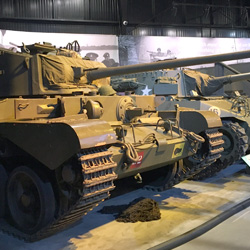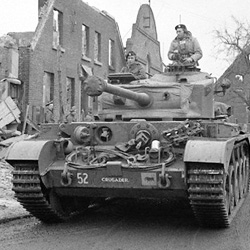The A34 was designed in 1943 and didn’t see production until February 1944. Its first scene of action during World War Two was when the 11th British armor division, the only division to fully reoutfit with Comets, crossed the Rhine River in March of 1945. The Comet saw limited use due to its introduction late in the war and because of the introduction of the heavy tank Centurion, which was right on the heels of the Comet in terms of production and was in most ways the A34’s superior. The British military used the Comet until 1958 and sold leftover ones to other countries.
The A34 Comet was a British medium tank that served as a replacement for the A27M Cromwell, the previous medium tank used by the British military. The Cromwell was able to bridge the gap between British and German armor in the early stages of the war but couldn’t contend with the later German tanks, most notably the Panther and the Tiger 1. Crews also lambasted the Cromwell’s 57mm QF 6 pounder main cannon due to the fact that the gun wasn’t very effective against softer targets such as artillery. This was because the ammunition was so small that high explosive rounds were ineffective simply because they couldn’t pack enough ordinance in the shells. Insufficient stopping power combined with a number of other issues with the Cromwell, such as tracks that slipped if the tank turned too sharply and finnicky track tensioning as well as relatively light armor, only 3 inches un-sloped in its thickest parts and 8mm in its thinnest, convinced the British that they needed a new tank.
The Comet addressed the issues with the Cromwell’s lackluster armor, track performance, and cannon versatility and improved upon them. The British had previously focused on making their tanks fast and light, but with experience from the African Campaign from June 1940- May 1943 they determined that sacrificing some speed for thicker armor was appropriate. As a result, the Comet took the Cromwell chassis and hull as a base and increased the armor to 74mm in the thickest parts and 34mm in the thinnest. The hull was also welded together rather than piece casted, which got rid of the need for many heavy rivets that could turn into projectiles if the tank was hit.
To the track they increased the tread width from 15.5” to 18.5”, strengthened the suspension and added return rollers to the top of the tracks that most other British tanks didn’t have. The large Christie suspension used in the Comet allowed for a very smooth ride but seriously cut into space on the inside of the tank. This made the interior very cramped for the crew, especially the driver and the loader, who didn’t have much space to move at all.
As far as the cannon goes, Britain tried to place the powerful 17 pdr gun onto a version of the Cromwell, but the cannon was too big, and it required shrinking the armor in the turret as well as increasing the size of the turret ring to make space, which the British refused to do. They choose to bore out 6 pdr rounds into a 75mm cannon and fire US ammunition instead. Vickers found a way to shrink the 17 pdr by loading the ordinance in a smaller QF 3-inch 20 cwt shell and increasing the pressure in it. This afforded Vickers to make the whole cannon smaller and fit it into a smaller turret ring.
The Comet comes close to a straight upgrade to the Cromwell, but British engineers chose to make a sacrifice of speed for reliability. The Cromwell was able to reach a max speed of about 40 mph, but the Rolls-Royce Mk III engine it utilized was ungoverned, which means the engine could experience unregulated torque and fatigue.
It is rare to have such a rich and detailed history about one single military artifact within the American Heritage Museum as with our A34 Comet Mk1A tank. We have a full account from Barry Weston, son of Stan Weston who was the original loader / operator for this tank. “This 33501 was the 101st production A34 Comet. It was delivered to the 11th Armored division around the 14th of December in Northern Belgium. T33501 was photographed and filmed on April 7th, 1945 crossing the Weser at Petershagan. C-Squadron were involved in battle at Loccum. Considerable opposition was encountered, but they dealt with seven 88mm guns without a loss. The Regiment continued its advance crossing the Aller and on April 15th elements of the 11th Armored division liberated the Bergen-Belsen concentration camp.”






